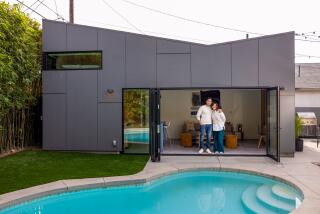Presenting Yourself in the Best Possible Light
- Share via
Here are some home-lighting recommendations from Fred Berryman, a lighting specialist since 1978 at the California Energy Commission in Sacramento.
Kitchen: The best combination is smaller general ceiling lights with compact fluorescents over work areas such as the sink. Separate switches allow you to turn on only the lights you need for each situation. Warning: Incandescent lights recessed in the ceiling waste energy.
Bathrooms: The recommendation is similar to kitchens. Because new California building codes require fluorescents in bathrooms and kitchens, the market has produced attractive full-sized and compact fluorescents.
Hallways: A ceiling-mounted compact fluorescent can spread light on hallway walls, providing a cheerful environment.
Family room/office: Consider cove lighting--lights mounted on the wall or near the ceiling behind decorative shields--to spread light evenly over the ceiling without glare. The inside of the shield should be highly reflective. Caution: Fluorescents are efficient, so avoid using too much light. Another strategy is to put several smaller lights in the cove and use a couple of switches to turn on several levels of lighting, which also serves as an inexpensive approach to dimming.
Bedroom: Bedrooms in new homes often have no overhead lighting--only switch-operated wall outlets. If you want overhead lights, consider cove lighting. But make sure you’re not making your bedroom as bright as an office.
Living room/dining room: Fluorescents in a cove may produce indirect light on a wall behind the couch or off the ceiling. You’d also want some table lamps and task lighting, such as reading lamps. To spotlight art work, use low-voltage halogen spotlights. Avoid energy-inefficient halogen torchiers.
Throughout the house: Consider controls and switches. In areas of infrequent use where children may leave lights on, sensors can turn off lights in timed intervals after someone leaves the space. Also, low voltage control systems with master panels allow you to shut off all the lights in the house by pushing one button when you leave in the morning.

